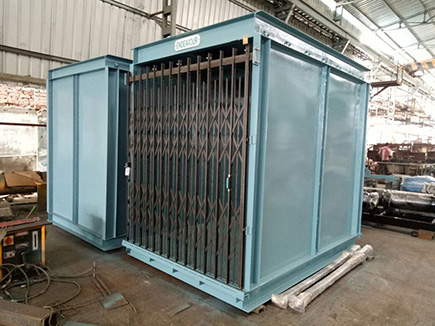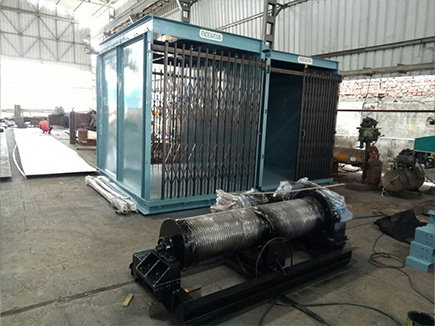Customizable Goods Lift for Efficient Material Handling
Looking for a reliable and heavy-duty goods lift to transfer materials across different levels of your warehouse or factory? Our range of hydraulic goods lift provides high-capacity solutions for industrial, commercial, and warehouse settings. Whether you need to handle heavy loads in a factory or streamline operations in a warehouse, our vertical goods lifts are designed to meet your needs.
Our goods lifts are designed to suit client-specific requirements using superior quality raw materials and high-grade components. The goods lifts (also known as cage lifts) are guided by steel guide members (T-section), ensuring stability and safety.
Hoisting and lowering operations are performed by our reliable electric wire rope hoist, and the system is operated via interlocked push buttons for ease of use. To ensure maximum safety, limit switches are installed.
We offer a variety of cage lifts in different sizes and capacities, all customized to your specific requirements. You can choose between models with or without a collapsible gate, ensuring flexibility based on your operational needs.
Our goods lifts provide efficient material transfer with robust construction, meeting the highest standards of durability and performance.
- Capacity: 0.5 ton to 7.5 ton
- Suitable for lifting loads vertically between floors.
- Cabin size: Customizable as per customer requirements, up to 16 feet.
- Easy to install.
- Maximum lift height: 12 meters for hydraulic lifts and up to 35 meters for electric goods lifts.
- Capacity range: 0.5 to 7.5 tons.
- Available with sliding and collapsible doors.
- Low maintenance.
Installation:

Goods Lift

Goods Lift

Goods Lift
Applications:

Oil & Gas

Pharmaceutical

Logistics

Food Processing

Chemical

Cement

Packing

Mining
Frequently Asked Questions (FAQ):
A Goods Lift, also known as a freight elevator or cargo lift, is a type of vertical transportation system used to lift and move goods or materials between different floors or levels within a building or facility.
- Warehouses
- Factories
- Distribution centers
- Retail stores
- Industrial facilities
- Construction sites
- Carriage or platform: The enclosed area where goods are placed for transport.
- Guide rails: Vertical or inclined rails that guide the movement of the lift car.
- Hoisting mechanism: Motorized system responsible for lifting and lowering the platform.
- Control panel: Interface for operating the lift and selecting desired floors.
- Safety features: Including door interlocks, emergency stop buttons, and overload protection devices.
- Efficient material handling: Allows for the quick and safe movement of goods between floors, reducing manual labor and improving productivity.
- Space-saving: Eliminates the need for manual carrying or use of stairs, optimizing floor space utilization.
- Safety: Incorporates various safety features to prevent accidents and ensure the protection of goods and personnel.
- Versatility: Can accommodate a wide range of load sizes, weights, and shapes, making them suitable for diverse industries and applications.
- Hydraulic Goods Lifts: Utilize hydraulic power to lift and lower the platform.
- Electric Goods Lifts: Operate using an electric motor and pulley system for vertical movement.
- Manual Goods Lifts: Require manual operation for lifting and lowering, suitable for smaller loads or low-frequency use.
- Goods Passenger Lifts: Designed to transport both goods and passengers simultaneously, commonly used in commercial buildings and malls.
Goods Lifts are available in various load capacities ranging from a few hundred kilograms to several tons, depending on the specific requirements of the application.
Yes, Goods Lifts can be customized with features such as different platform sizes, door configurations, and control options to suit the unique needs and space constraints of each application.
Goods Lifts must comply with relevant safety standards and regulations, including those related to structural integrity, electrical safety, and load capacity limits. Regular maintenance and inspections are also essential to ensure safe operation.







